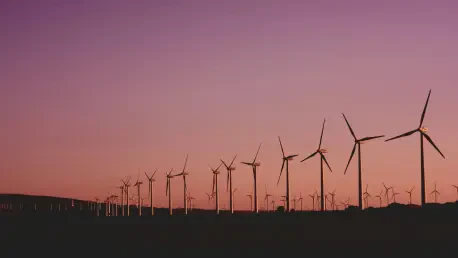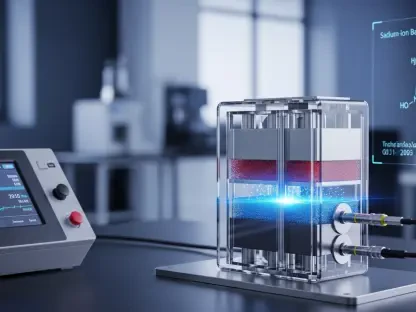The Doubly Fed Induction Generator (DFIG) System Market is poised for substantial expansion, with a projected Compound Annual Growth Rate (CAGR) of 5.7% from the current year through 2035. These systems, integral to modern wind turbines, play a critical role in enabling efficient energy conversion and seamless integration with power grids, particularly in variable-speed operations for both onshore and offshore wind projects. As the world intensifies its focus on renewable energy to combat climate change and reduce reliance on fossil fuels, DFIG technology stands out for its ability to maximize energy capture while maintaining grid stability. This makes it a cornerstone of the global transition to sustainable power generation. Amid rising environmental concerns and supportive governmental policies, the adoption of wind energy solutions continues to accelerate, positioning DFIG systems as a key enabler in meeting ambitious clean energy targets. This article delves into the driving forces behind this market’s growth, the technological advancements shaping its trajectory, and the regional dynamics influencing its adoption worldwide.
Forces Fueling Market Expansion
The growth of the DFIG System Market is largely driven by the escalating global demand for renewable energy sources as nations commit to stringent sustainability goals. Wind energy, bolstered by DFIG technology, provides a scalable and efficient means to cut down on greenhouse gas emissions while ensuring a stable power supply to grids. Unlike older fixed-speed systems, DFIG systems allow turbines to adjust dynamically to varying wind speeds, optimizing energy output and reducing mechanical stress on turbine components. This adaptability not only enhances efficiency but also extends the operational lifespan of wind installations. Furthermore, the push for energy security amid volatile fossil fuel markets has prompted significant investments in wind power, with DFIG systems emerging as a preferred choice due to their proven reliability in diverse conditions. As countries ramp up efforts to diversify energy portfolios, the strategic importance of such technology in achieving a cleaner, more resilient energy future becomes increasingly evident.
Another pivotal factor propelling this market is the economic viability of DFIG systems, which, despite higher initial costs, deliver long-term savings through superior energy efficiency and reduced operational losses. The resulting lower Levelized Cost of Energy (LCOE) makes these systems highly attractive to project developers and investors seeking sustainable returns. Government incentives, including subsidies, tax breaks, and favorable feed-in tariffs, further accelerate adoption in key regions such as the United States, Germany, and China. These policies are particularly impactful in supporting large-scale offshore wind farms, where DFIG systems excel due to their ability to handle challenging environmental conditions and provide critical grid support. The convergence of economic benefits and policy backing creates a robust foundation for market growth, ensuring that DFIG technology remains a vital component of the renewable energy landscape as global energy demands continue to rise.
Innovations Driving System Performance
Technological progress is fundamentally transforming the DFIG System Market by enhancing both the performance and reliability of wind turbine operations. Advanced rotor-side converters have become a game-changer, enabling precise control over active and reactive power flows, which allows turbines to respond swiftly to fluctuations in grid conditions. This capability is crucial for maintaining stability in modern power networks, especially as renewable energy penetration increases. Additionally, the integration of energy storage solutions, such as lithium-ion batteries, addresses the inherent intermittency of wind power by capturing excess energy during high-wind periods for use during lulls. Such advancements ensure a more consistent energy supply, bolstering the dependability of wind farms equipped with DFIG systems. As these technologies continue to evolve, they pave the way for broader adoption in complex grid environments, reinforcing the role of DFIG systems in sustainable energy ecosystems.
Beyond power control and storage, the incorporation of smart monitoring tools powered by Internet of Things (IoT) technology and data analytics marks another significant leap forward. These systems provide real-time insights into the health of critical components like rotors and stators, enabling predictive maintenance that prevents costly failures before they occur. By minimizing downtime and optimizing repair schedules, such innovations substantially reduce operational expenses while extending the lifespan of wind turbines. Enhanced fault ride-through (FRT) capabilities also ensure that DFIG systems can withstand grid disturbances, such as voltage dips, without disconnecting, thereby improving overall system resilience. These technological strides not only elevate the efficiency of wind energy projects but also build confidence among stakeholders in the reliability of DFIG systems, fostering greater investment and deployment in both established and emerging markets.
Global Adoption and Regional Variations
The adoption of DFIG systems varies significantly across different regions, shaped by disparities in policy frameworks, infrastructure development, and commitment to renewable energy. Europe stands as the frontrunner, with nations like Germany, Denmark, and Spain benefiting from a mature wind industry supported by robust government initiatives and ambitious clean energy targets. A well-developed manufacturing base and extensive grid infrastructure further solidify Europe’s leadership in deploying DFIG technology, particularly in offshore wind projects that demand high efficiency and grid compatibility. This region’s proactive approach to reducing carbon emissions through wind power serves as a benchmark for others, demonstrating how strategic investments and regulatory support can drive technological adoption. As Europe continues to expand its renewable capacity, DFIG systems remain central to achieving long-term sustainability objectives.
In contrast, the Asia-Pacific region is witnessing the most rapid growth in the DFIG System Market, propelled by massive wind energy installations in countries like China and India. China, in particular, dominates due to its extensive domestic manufacturing capabilities and aggressive policies aimed at curbing pollution through renewable energy expansion. North America, led by the United States and Canada, shows steady progress with clean energy initiatives fueling wind project development in areas like the Midwest and coastal regions. Meanwhile, emerging markets in Latin America, the Middle East, and Africa are beginning to tap into DFIG technology to build their renewable energy capacities, leveraging its grid integration strengths to address variable wind patterns and infrastructure challenges. These regional differences highlight the diverse pathways through which DFIG systems are contributing to the global renewable energy transition, adapting to local needs and priorities.
Future Prospects and Strategic Considerations
Looking ahead, the DFIG System Market is set to play an increasingly vital role in the renewable energy sector as the world prioritizes sustainable power generation to meet growing energy demands. The projected growth at a CAGR of 5.7% through 2035 reflects the technology’s alignment with evolving grid requirements and environmental imperatives. As smart grid systems become more prevalent, the ability of DFIG systems to control reactive power and ensure voltage stability will be even more critical, positioning them as indispensable assets in modern energy networks. Stakeholders must focus on scaling up investments in research and development to further refine system efficiencies and address remaining challenges like intermittency and high upfront costs. Collaborative efforts between governments, industry players, and technology innovators will be essential to unlock the full potential of DFIG systems in diverse applications.
To sustain this momentum, strategic planning should emphasize the expansion of offshore wind projects, where DFIG technology has demonstrated exceptional performance under harsh conditions. Policymakers are encouraged to strengthen incentives and streamline regulatory processes to attract private investments, particularly in emerging markets where renewable energy infrastructure is still developing. Additionally, integrating DFIG systems with hybrid renewable setups that combine wind, solar, and storage solutions can offer a more reliable energy output, mitigating the limitations of standalone systems. By fostering innovation and building global partnerships, the industry can ensure that DFIG technology continues to contribute meaningfully to energy security and climate goals, shaping a future where clean power is both accessible and dependable for generations to come.









